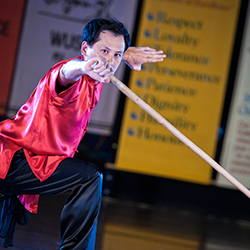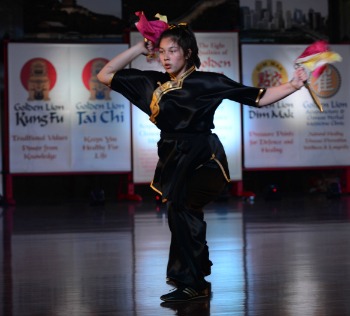Specialised Kung Fu Bare Hands & Weaponry Forms Class
The practice of kung fu forms originated in China around 525 CE when an Indian monk named Bodidharma taught Shaolin monks a series of exercises to increase their physical fitness and overall health to improve their ability to remain awake during deep meditation. These forms were revised and improved over time, resulting in five animal-based styles, dragon, tiger, leopard, crane and snake, which are directly related to the forms taught at Golden Lion today. Each different animal style is designed for a specific purpose:

- dragon, to improve spirit, flexibility and graceful movements;
- tiger, to strengthen bones;
- leopard, for increasing strength, power and speed;
- crane, for improving vitality, balance and stronger tendons; and
- snake, to cultivate chi and striking accuracy.
There are obvious differences between the practice of kung fu forms and self defence applications. While self defence applications represent the practical application of kung fu, the various forms are the foundations upon which all further practice is based and therefore the regular practice of forms is critical to improving as a kung fu student.
In self defence, the ability to move quickly is important, so stances are higher to allow for smooth and free footwork. In contrast, stances in forms need to show strength, flexibility and balance, depending on the stance. For example, one leg stances in the 32 and Elementary barehands forms, or the Southern Broadsword form, show balance. The horse and dragon stances in all forms demonstrate strength and flexibility by keeping low and strong.
When practicing forms, an important aspect of learning routines is remembering the various individual moves and then combining them together into a complete routine. The first rule is a simple one: practice, practice and practice more. As kung fu can be translated to mean time spent in hard work, repeating the lessons learned in class over and over is one way to cement the routine in your mind.
Another technique for remembering routines is breaking the routine down into three-technique groups that help embed the routine into our minds. This is a similar memorisation technique to chunking, where a complex set of information is broken into smaller chunks that are more easily recalled. Grouping the steps together not only helps with learning the whole routine, but also helps to apply the right tempo, by deciding when to move quickly and when to pause to show stances and strikes clearly. For example, the three-move combination tiger cross steps and tiger claw strike at the end of the Elementary Form can be performed with two quick cross steps before a slight pause and then the tiger claw strike (step, step, pause, 3).
A new form, whether it is the 16 form learnt as part of Level 1 or the longer Southern Fist form, tends to feel foreign and long when you first begin to learn it. However, with regular practice there will come a time when all of the separate moves come together and you can perform the routine without the need to think through every individual technique. Suddenly, what originally felt like a long and complicated routine becomes second nature and it is over before you know it. This is when further improvement becomes the focus.
Once a routine is memorised, students can begin to apply to concepts of “smooth as silk, hard as iron, fast as lightning”. To demonstrate knowledge and understanding of a routine, it’s not enough to just know the moves; you need to understand the intent of the different moves and be able to show this. For example, during a transition move it’s more important to move quickly and lightly, rather than low and strong, to get to the next strike technique where you can show a strong stance and clear and accurate strike.

The first focus should be smoothness, which means to complete each move completely and show its intent accurately. Once this is achieved, the power should be focussed on; this adds spirit into the routine and shows the intent of the moves as kung fu techniques- kicks, punches, blocks, grabs and so on. Once “smooth as silk, hard as iron” are incorporated together into the routine, speed can be added. It’s important to focus on speed as a third element, as it is easy to lose clarity and power demonstrated when moving faster as there is a tendency to rush from one move to the next without completing it, which impacts on the quality and power of each move. “Fast as lightning” doesn’t necessarily mean completing the routine as fast as possible- there are times when a pause is very effective, for example to show balance or strength in a stance, or highlight the strength of a strike.
So when it comes to learning routines, whether barehands or weapons, it pays to remember what the masters and instructors teach us: “smooth as silk, hard as iron, fast as lightning.” Keeping these concepts in mind will help to improve learning and demonstrating kung fu forms to the high Golden Lion standard.
Each Tuesday night at Rowville, Sifu Steeve runs a specialised class focussed on kung fu forms. This class was originally aimed at establishing a program in addition to the standard kung fu syllabus to develop an entry for Golden Lion students into local and national competitions. Where the traditional kung fu classes teach the basic elements of kung fu and aim to develop students’ skills and progress them towards their next grading, the specialised bare hands and weaponry class focuses solely on forms.
This provides the opportunity to spend a couple of hours breaking down forms into their parts and perfecting their execution, then combining the sections into a seamless fabric.
To join in this class you can contact Sifu Steeve on 9796 1066. More information about Golden Lion’s Weapons training can be found here.
Adam Swanwick, Rowville Kung Fu student.
